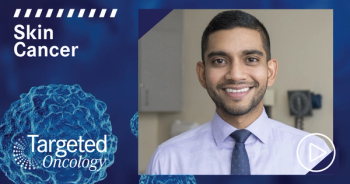
Parting Advice on Non-Melanoma Skin Cancer Management
Shubham Pant, MD:Any last comments for the community oncologists out there who are dealing with these patients? What would you tell them about this disease, about locally advanced cutaneous cell cancer or about basal cell cancers? Any take-home points for them?
Michael R. Migden, MD:I’ve got a lot of take-home points.
Shubham Pant, MD:Sure. Let’s start with cutaneous squamous cell cancer [cSCC].
Michael R. Migden, MD:In cutaneous squamous cell carcinoma, metastatic disease is one that pretty much everybody knows what it is. It can be a locoregional such as lymph nodes in the parotid or neck, and it can be distant metastasis. The locally advanced cSCC, the mindset of how to classify it as such and what to do about it is something that requires a little bit of increased awareness and perhaps some education. I’ll say surgeons, and I consider myself at least partly in that category, and radiation oncologists traditionally have thought basically that I have a hammer and most everything looks like a nail. If I can see it, I can operate on it or radiate it. And now that we have an approved agent to treat locally advanced disease, it’s important to take a step back and think whether you’re really having a good chance of success by continuing to repeat surgery and radiation.
Then the concept of locally advanced cSCC is an important one. It’s a multifaceted, somewhat nuanced presentation. It can occur as an exophytic lesion, an endophytic lesion where the top of the tumor has already been removed and there’s just a recurrence deeply or perineural involvement. You can have full thickness erosion such as orocutaneous fistulas, nasal cutaneous fistulas. And more importantly, it’s not just tumors that can’t be removed: the reason that these patients aren’t candidates for further surgery or radiation can be varied.
For example, a rhinectomy where you’re going to remove the whole nose. Technically that surgery can be done, but you might not find that the patient likes the idea of that too much. So the study allowed for patients where surgery could technically be done, but it would result in severe disfigurement or dysfunction. And I would consider any newer patients on prescription drug the same way. It’s not just a matter of whether surgery can be done, but what are the consequences of the surgery.
It’s very important to recognize that there are not only these varied presentations of locally advanced disease, but there are a lot of patient-specific considerations, in both the diagnosis and treatment of these diseases. So starting with a multidisciplinary board discussion of what kinds of treatments would be appropriate for the patient, that would be the first step, and then taking it to the patient after you’ve had that discussion and saying, “OK, this was the recommendation. But how do you feel about it, patient?” Because if the patient says, “I’d rather die than have another big surgery because I’ve had so many.”
Shubham Pant, MD:They can be disfiguring.
Michael R. Migden, MD:Yes, but they may just say, “I have surgical fatigue. I’ve been through massive surgeries. I have dysfunction from prior surgery and radiation, and I would rather die than have another big one.” There’s little argument to say, “Well, I’m sorry but that’s what you have to have.” So these are important discussions and the final determination should be a patient/physician discussion, not an exact definition, “Well, you don’t meet these exact criteria for locally advanced disease.”
Shubham Pant, MD:Thank you, Dr Migden for this insightful discussion. And thank you to our audience for joining us during thisTargeted Oncologypresentation on non-melanoma skin cancers.
Transcript edited for clarity.








































